12.3: Brain- Cerebrum
- Page ID
- 27883
\( \newcommand{\vecs}[1]{\overset { \scriptstyle \rightharpoonup} {\mathbf{#1}} } \)
\( \newcommand{\vecd}[1]{\overset{-\!-\!\rightharpoonup}{\vphantom{a}\smash {#1}}} \)
\( \newcommand{\dsum}{\displaystyle\sum\limits} \)
\( \newcommand{\dint}{\displaystyle\int\limits} \)
\( \newcommand{\dlim}{\displaystyle\lim\limits} \)
\( \newcommand{\id}{\mathrm{id}}\) \( \newcommand{\Span}{\mathrm{span}}\)
( \newcommand{\kernel}{\mathrm{null}\,}\) \( \newcommand{\range}{\mathrm{range}\,}\)
\( \newcommand{\RealPart}{\mathrm{Re}}\) \( \newcommand{\ImaginaryPart}{\mathrm{Im}}\)
\( \newcommand{\Argument}{\mathrm{Arg}}\) \( \newcommand{\norm}[1]{\| #1 \|}\)
\( \newcommand{\inner}[2]{\langle #1, #2 \rangle}\)
\( \newcommand{\Span}{\mathrm{span}}\)
\( \newcommand{\id}{\mathrm{id}}\)
\( \newcommand{\Span}{\mathrm{span}}\)
\( \newcommand{\kernel}{\mathrm{null}\,}\)
\( \newcommand{\range}{\mathrm{range}\,}\)
\( \newcommand{\RealPart}{\mathrm{Re}}\)
\( \newcommand{\ImaginaryPart}{\mathrm{Im}}\)
\( \newcommand{\Argument}{\mathrm{Arg}}\)
\( \newcommand{\norm}[1]{\| #1 \|}\)
\( \newcommand{\inner}[2]{\langle #1, #2 \rangle}\)
\( \newcommand{\Span}{\mathrm{span}}\) \( \newcommand{\AA}{\unicode[.8,0]{x212B}}\)
\( \newcommand{\vectorA}[1]{\vec{#1}} % arrow\)
\( \newcommand{\vectorAt}[1]{\vec{\text{#1}}} % arrow\)
\( \newcommand{\vectorB}[1]{\overset { \scriptstyle \rightharpoonup} {\mathbf{#1}} } \)
\( \newcommand{\vectorC}[1]{\textbf{#1}} \)
\( \newcommand{\vectorD}[1]{\overrightarrow{#1}} \)
\( \newcommand{\vectorDt}[1]{\overrightarrow{\text{#1}}} \)
\( \newcommand{\vectE}[1]{\overset{-\!-\!\rightharpoonup}{\vphantom{a}\smash{\mathbf {#1}}}} \)
\( \newcommand{\vecs}[1]{\overset { \scriptstyle \rightharpoonup} {\mathbf{#1}} } \)
\( \newcommand{\vecd}[1]{\overset{-\!-\!\rightharpoonup}{\vphantom{a}\smash {#1}}} \)
\(\newcommand{\avec}{\mathbf a}\) \(\newcommand{\bvec}{\mathbf b}\) \(\newcommand{\cvec}{\mathbf c}\) \(\newcommand{\dvec}{\mathbf d}\) \(\newcommand{\dtil}{\widetilde{\mathbf d}}\) \(\newcommand{\evec}{\mathbf e}\) \(\newcommand{\fvec}{\mathbf f}\) \(\newcommand{\nvec}{\mathbf n}\) \(\newcommand{\pvec}{\mathbf p}\) \(\newcommand{\qvec}{\mathbf q}\) \(\newcommand{\svec}{\mathbf s}\) \(\newcommand{\tvec}{\mathbf t}\) \(\newcommand{\uvec}{\mathbf u}\) \(\newcommand{\vvec}{\mathbf v}\) \(\newcommand{\wvec}{\mathbf w}\) \(\newcommand{\xvec}{\mathbf x}\) \(\newcommand{\yvec}{\mathbf y}\) \(\newcommand{\zvec}{\mathbf z}\) \(\newcommand{\rvec}{\mathbf r}\) \(\newcommand{\mvec}{\mathbf m}\) \(\newcommand{\zerovec}{\mathbf 0}\) \(\newcommand{\onevec}{\mathbf 1}\) \(\newcommand{\real}{\mathbb R}\) \(\newcommand{\twovec}[2]{\left[\begin{array}{r}#1 \\ #2 \end{array}\right]}\) \(\newcommand{\ctwovec}[2]{\left[\begin{array}{c}#1 \\ #2 \end{array}\right]}\) \(\newcommand{\threevec}[3]{\left[\begin{array}{r}#1 \\ #2 \\ #3 \end{array}\right]}\) \(\newcommand{\cthreevec}[3]{\left[\begin{array}{c}#1 \\ #2 \\ #3 \end{array}\right]}\) \(\newcommand{\fourvec}[4]{\left[\begin{array}{r}#1 \\ #2 \\ #3 \\ #4 \end{array}\right]}\) \(\newcommand{\cfourvec}[4]{\left[\begin{array}{c}#1 \\ #2 \\ #3 \\ #4 \end{array}\right]}\) \(\newcommand{\fivevec}[5]{\left[\begin{array}{r}#1 \\ #2 \\ #3 \\ #4 \\ #5 \\ \end{array}\right]}\) \(\newcommand{\cfivevec}[5]{\left[\begin{array}{c}#1 \\ #2 \\ #3 \\ #4 \\ #5 \\ \end{array}\right]}\) \(\newcommand{\mattwo}[4]{\left[\begin{array}{rr}#1 \amp #2 \\ #3 \amp #4 \\ \end{array}\right]}\) \(\newcommand{\laspan}[1]{\text{Span}\{#1\}}\) \(\newcommand{\bcal}{\cal B}\) \(\newcommand{\ccal}{\cal C}\) \(\newcommand{\scal}{\cal S}\) \(\newcommand{\wcal}{\cal W}\) \(\newcommand{\ecal}{\cal E}\) \(\newcommand{\coords}[2]{\left\{#1\right\}_{#2}}\) \(\newcommand{\gray}[1]{\color{gray}{#1}}\) \(\newcommand{\lgray}[1]{\color{lightgray}{#1}}\) \(\newcommand{\rank}{\operatorname{rank}}\) \(\newcommand{\row}{\text{Row}}\) \(\newcommand{\col}{\text{Col}}\) \(\renewcommand{\row}{\text{Row}}\) \(\newcommand{\nul}{\text{Nul}}\) \(\newcommand{\var}{\text{Var}}\) \(\newcommand{\corr}{\text{corr}}\) \(\newcommand{\len}[1]{\left|#1\right|}\) \(\newcommand{\bbar}{\overline{\bvec}}\) \(\newcommand{\bhat}{\widehat{\bvec}}\) \(\newcommand{\bperp}{\bvec^\perp}\) \(\newcommand{\xhat}{\widehat{\xvec}}\) \(\newcommand{\vhat}{\widehat{\vvec}}\) \(\newcommand{\uhat}{\widehat{\uvec}}\) \(\newcommand{\what}{\widehat{\wvec}}\) \(\newcommand{\Sighat}{\widehat{\Sigma}}\) \(\newcommand{\lt}{<}\) \(\newcommand{\gt}{>}\) \(\newcommand{\amp}{&}\) \(\definecolor{fillinmathshade}{gray}{0.9}\)- Name the major regions of the adult brain
- Identify the anatomical structures of the cerebrum
- Identify the tracts associated with the white matter of the cerebrum and describe their functions
- Describe the components of the cerebral nuclei
- Describe the functional areas of the cerebral cortex and their locations
The organs of the central nervous system are the brain and spinal cord. The brain is described in terms of four major regions: the cerebrum, the diencephalon, the brainstem, and the cerebellum (Figure \(\PageIndex{1}\)). The iconic gray mantle of the human brain, which appears to make up most of the mass of the brain, is the cerebrum. Many of the higher neurological functions, such as memory, emotion, and consciousness, are the result of cerebral function. The cerebrum is divided into different regions called lobes. Overall, the functions of the cerebrum are initiation and coordination of movement, processing of general and special senses, and high level functions such as judgment, reasoning, problem solving, and learning.
Cerebrum
The cerebrum is covered by a continuous layer of gray matter that wraps around either side of the forebrain—the cerebral cortex. This thin, extensive region of wrinkled gray matter is responsible for the higher functions of the nervous system. A gyrus (plural = gyri) is the ridge of one of those wrinkles, and a sulcus (plural = sulci) is the groove between two gyri (Figure \(\PageIndex{1}\)). The pattern of these folds of tissue indicates specific regions of the cerebral cortex. The brain must fit inside the cranial cavity of the skull. Extensive folding in the cerebral cortex enables more gray matter to fit into this limited space. If the gray matter of the cortex were peeled off of the cerebrum and laid out flat, its surface area would be roughly equal to one square meter. The folding of the cortex maximizes the amount of gray matter in the cranial cavity. During embryonic development, as the telencephalon expands within the skull, the brain goes through a regular course of growth that results in everyone’s brain having a similar pattern of folds.
The surface of the brain can be mapped on the basis of the locations of large gyri and sulci. Three deep sulci are visible: the central sulcus, the lateral sulcus and the parieto-occipital sulcus. Anterior to the central sulcus is the precentral gyrus, while posterior to the central sulcus is the postcentral gyrus (Figure \(\PageIndex{1}\)). There is a large separation between the two sides of the cerebrum called the longitudinal fissure (Figure \(\PageIndex{2}\)). It separates the cerebrum into two distinct halves, a right and left cerebral hemisphere.
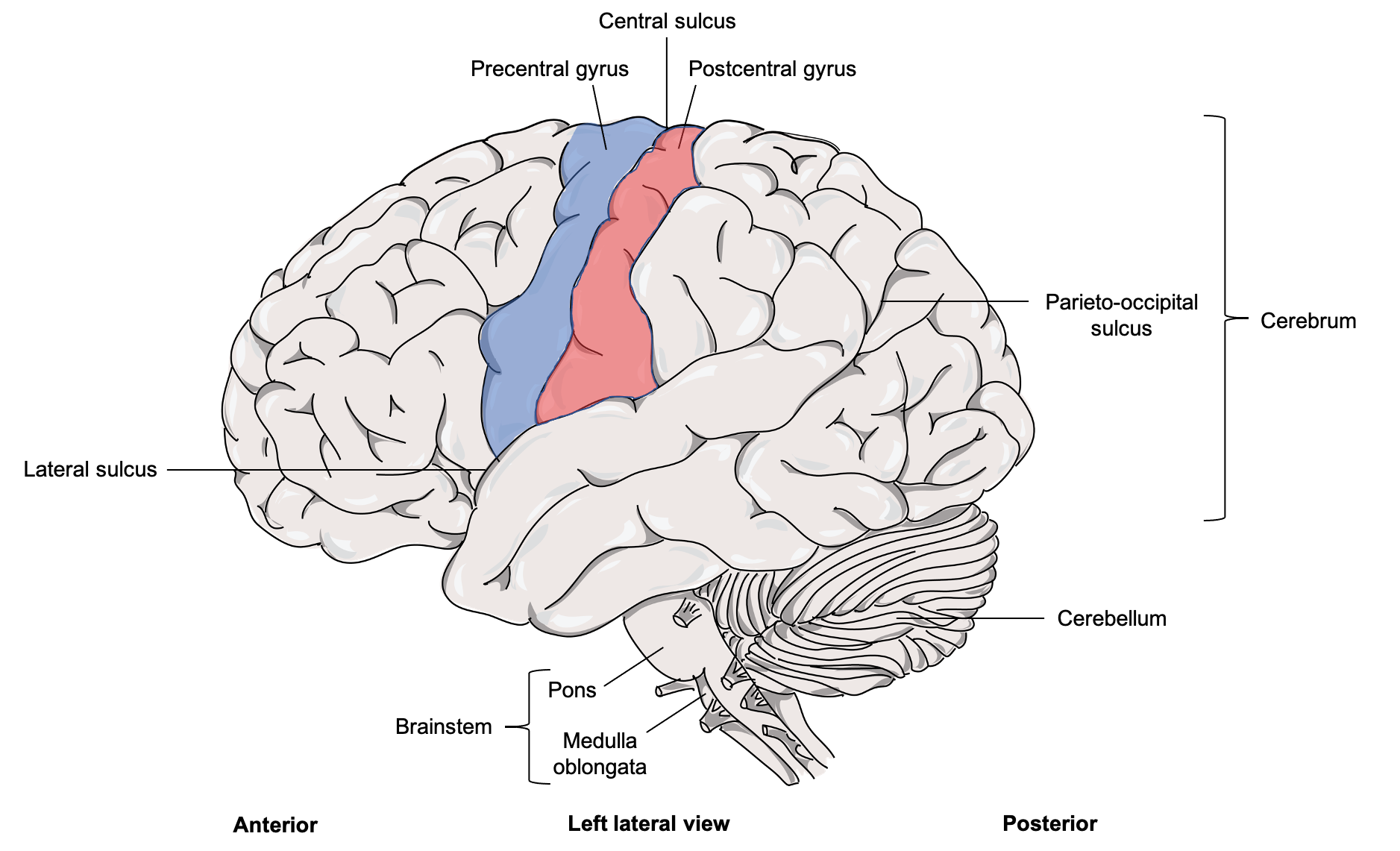
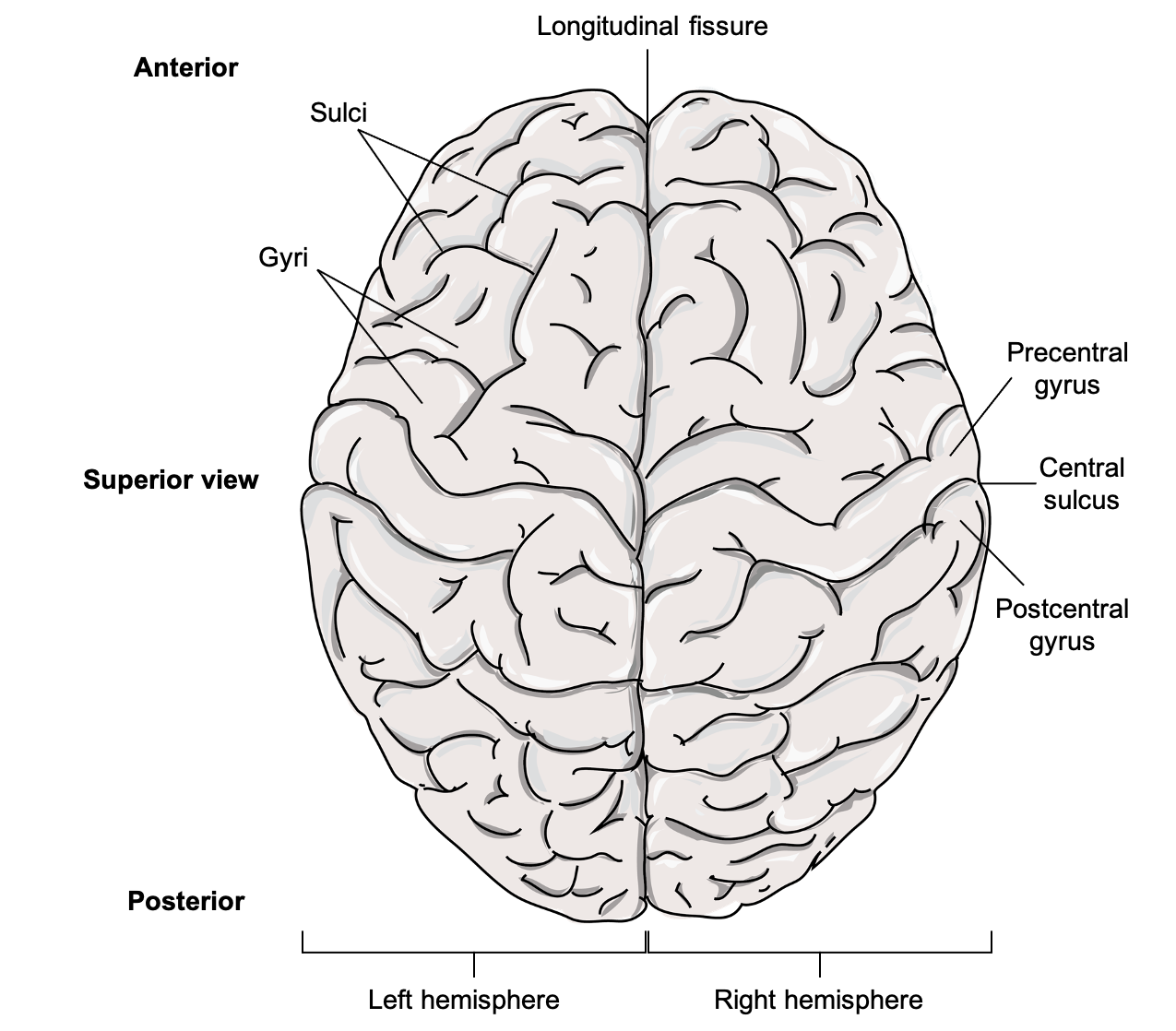
The cerebrum comprises the outer wrinkled gray matter that is the cerebral cortex (from the Latin word meaning “bark of a tree”), the inner white matter that forms tracts, and several deep (subcortical) nuclei called basal nuclei (Figure \(\PageIndex{3}\)). Deep within the cerebrum, the white matter of the corpus callosum provides the major pathway for communication between the two hemispheres of the cerebral cortex.
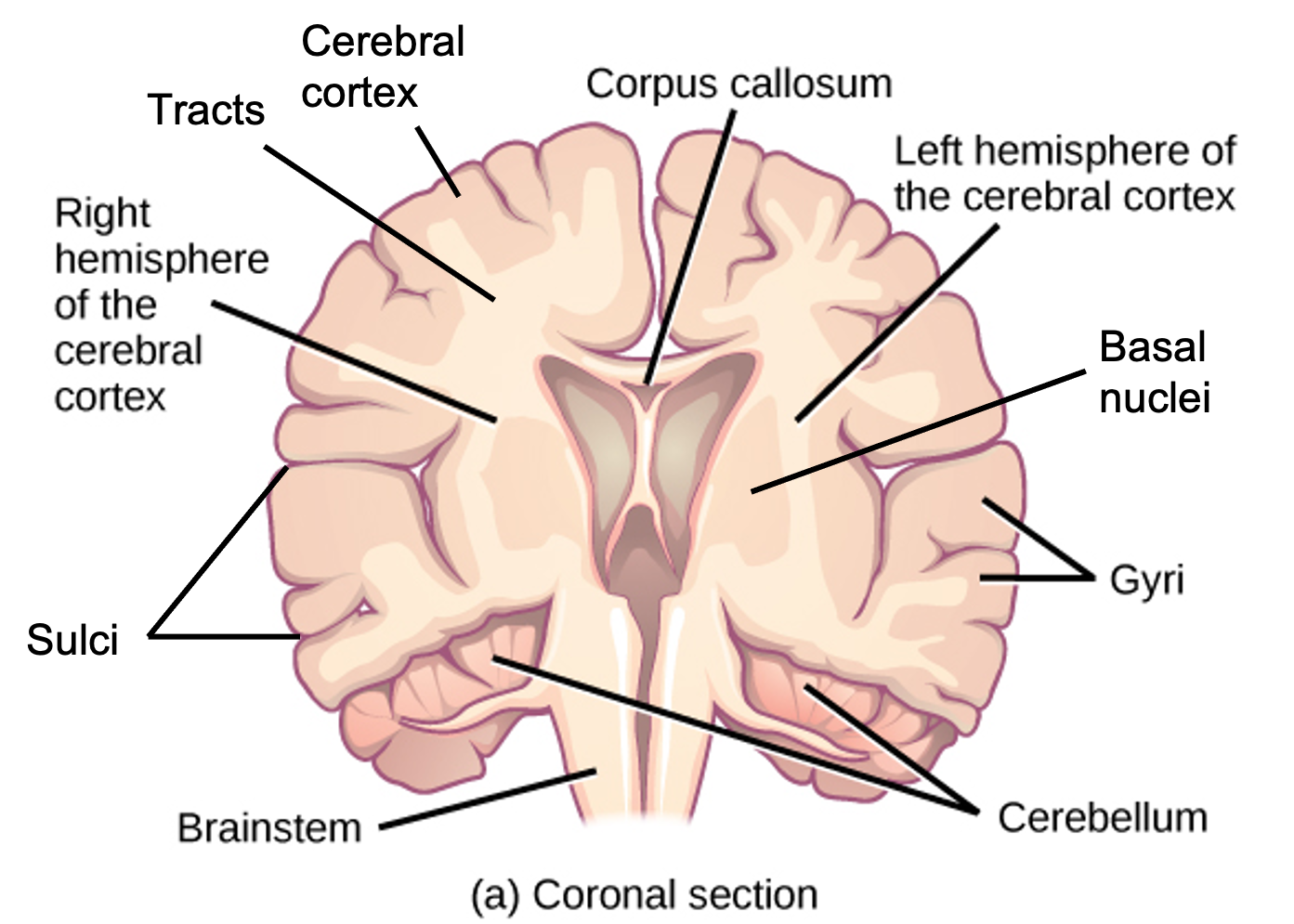
Cerebral Cortex
The cortex can be separated into major regions called lobes (Figure \(\PageIndex{4}\)). The lateral sulcus separates the temporal lobe from the other regions. Deep to the lateral sulcus is another lobe called insula (shown in Figure \(\PageIndex{5}\)). Superior to the lateral sulcus are the parietal lobe and frontal lobe, which are separated from each other by the central sulcus. The posterior region of the cortex is the occipital lobe, which has no obvious anatomical border between it and the parietal or temporal lobes on the lateral surface of the brain. From the medial surface, an obvious landmark separating the parietal and occipital lobes is called the parieto-occipital sulcus.
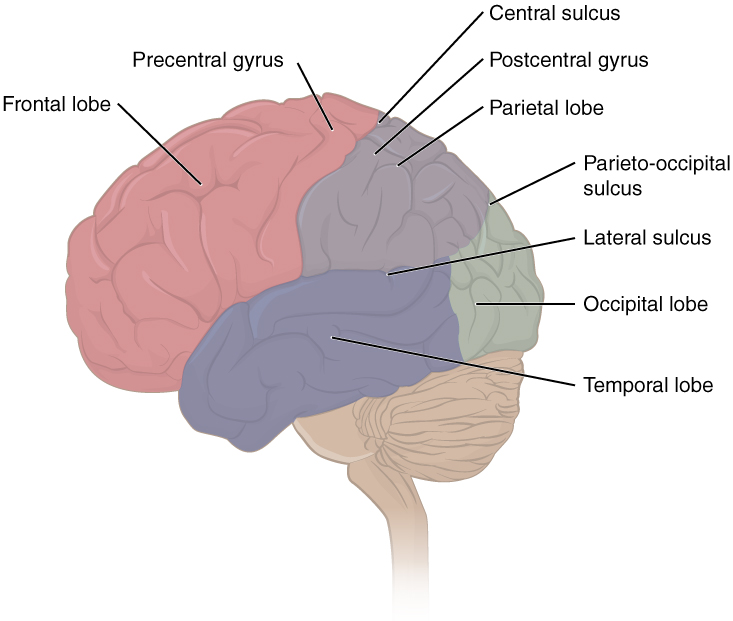
Basal Nuclei
Beneath the cerebral cortex are sets of nuclei known as basal nuclei that augment cortical processes. The basal nuclei are also referred to as the basal ganglia, although that is potentially confusing because the term ganglia is typically used for peripheral nervous system structures. The basal nuclei include the caudate, putamen, and globus pallidus in the cerebrum, the subthalamic nucleus in the diencephalon, the substantia nigra in the midbrain of the brainstem and the limbic system.
The major structures of the basal nuclei that control movement are the caudate, putamen, and globus pallidus, which are located deep in the cerebrum. The caudate is a long nucleus that follows the basic C-shape of the cerebrum from the frontal lobe, through the parietal and occipital lobes, into the temporal lobe. The putamen is mostly deep in the anterior regions of the frontal and parietal lobes. Together, the caudate and putamen are called the striatum. The globus pallidus is a layered nucleus that lies just medial to the putamen; they are called the lenticular nuclei because they look like curved pieces fitting together like lenses. The globus pallidus has two subdivisions, the external and internal segments, which are lateral and medial, respectively. These nuclei are depicted in a frontal section of the brain in Figure \(\PageIndex{5}\). The basal nuclei in the cerebrum are connected with a few more nuclei in the brainstem that together act as a functional group that forms a motor pathway. The basal nuclei are responsible for comparing cortical processing with the general state of activity in the nervous system to influence the likelihood of movement taking place. For example, while a student is sitting in a classroom listening to a lecture, the basal nuclei will keep the urge to jump up and scream from actually happening.
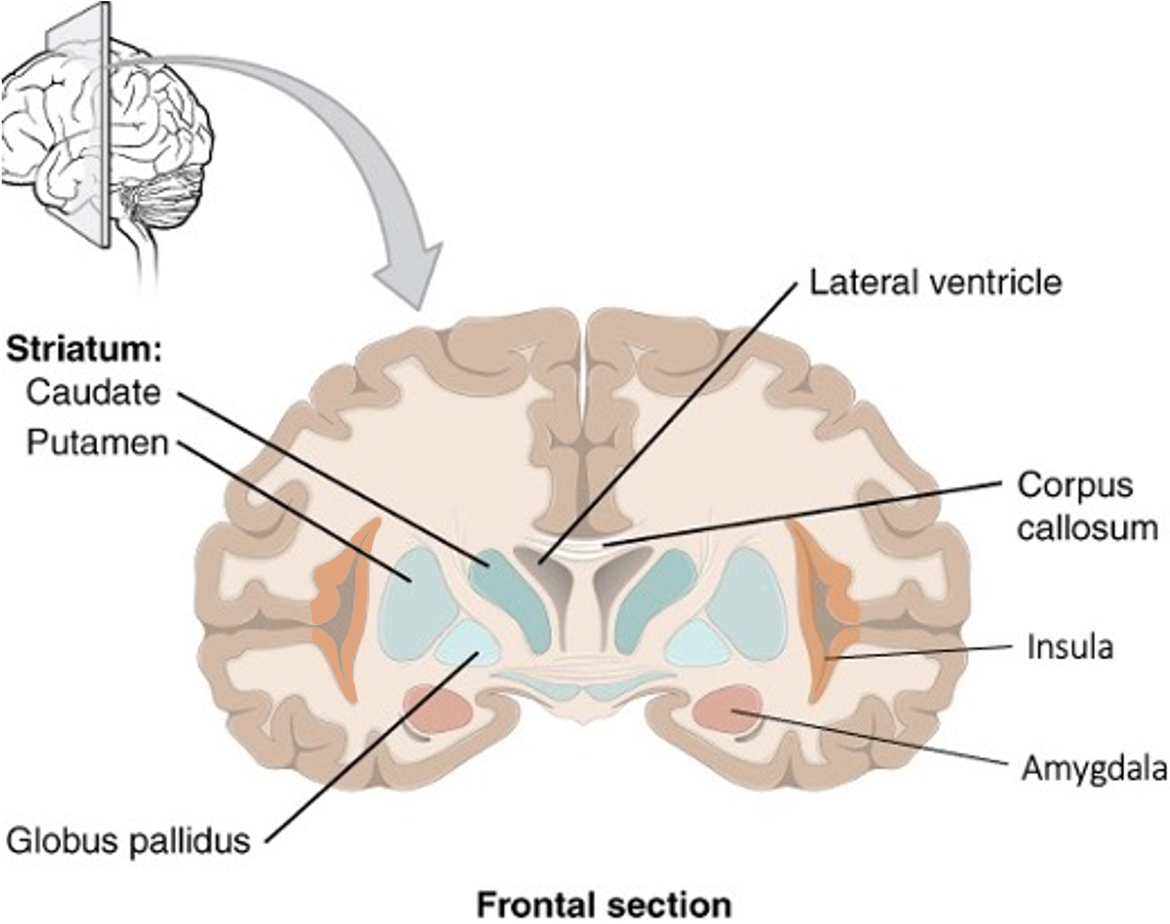
White Matter Tracts
The white matter lies deep to the cerebral cortex and is mainly made by myelinated axons, which gives the white appearance. The axons are grouped into bundles called tracts that connect different regions of the cerebral cortex to integrate information and motor response. The white matter tracts of the cerebrum can be classified into three groups: commissural tracts, association tracts and projection tracts (Figure \(\PageIndex{6}\)).
Commissural tracts extend between the two hemispheres to connect left and right regions of the cerebrum. The most prominent commissural tract, and largest white matter structure, is the corpus callosum. Association tracts connect different regions within the same hemisphere. Association tracts can be classified into arcuate fibers when they connect gyri of the same lobe or longitudinal fasciculi when they connect gyri in different lobes of the same hemisphere. Projection tracts extend from the cerebral cortex to the inferior regions of the brain and to the spinal cord.

Left Brain, Right Brain
Popular media often refer to right-brained and left-brained people, as if the brain were two independent halves that work differently for different people. This is a popular misinterpretation of an important neurological phenomenon. As an extreme measure to deal with a debilitating condition, the corpus callosum may be sectioned to overcome intractable epilepsy. When the connections between the two cerebral hemispheres are cut, interesting effects can be observed.
If a person with an intact corpus callosum is asked to put their hands in their pockets and describe what is there on the basis of what their hands feel, they might say that they have keys in their right pocket and loose change in the left. They may even be able to count the coins in their pocket and say if they can afford to buy a candy bar from the vending machine. If a person with a sectioned corpus callosum is given the same instructions, they will do something quite peculiar. They will only put their right hand in their pocket and say they have keys there. They will not even move their left hand, much less report that there is loose change in the left pocket.
The reason for this is that the language functions of the cerebral cortex are localized to the left hemisphere in 95 percent of the population. Additionally, the left hemisphere is connected to the right side of the body through the corticospinal tract and the ascending tracts of the spinal cord. Motor commands from the precentral gyrus control the opposite side of the body, whereas sensory information processed by the postcentral gyrus is received from the opposite side of the body. For a verbal command to initiate movement of the right arm and hand, the left side of the brain needs to be connected by the corpus callosum. Language is processed in the left side of the brain and directly influences the left brain and right arm motor functions, but is sent to influence the right brain and left arm motor functions through the corpus callosum. Likewise, the left-handed sensory perception of what is in the left pocket travels across the corpus callosum from the right brain, so no verbal report on those contents would be possible if the hand happened to be in the pocket.
Functional Areas of the Cerebrum
The cerebrum is responsible for the perception of sensation and for controlling the skeletal muscles. The cerebrum is also the seat of many of the higher mental functions, such as memory and learning, and language. These higher functions are distributed across various regions of the cortex, and specific locations can be said to be responsible for particular functions.
The frontal lobe is responsible for motor functions, from planning movements through executing commands to be sent to the spinal cord and periphery. The most anterior portion of the frontal lobe is the prefrontal cortex, which is associated with aspects of personality through its influence on motor responses in decision-making. The other lobes are responsible for sensory functions. The main sensation associated with the parietal lobe is somatosensation, meaning the general sensations associated with the body. The occipital lobe is where visual processing begins, although the other parts of the brain can contribute to visual function. The temporal lobe contains the cortical area for auditory processing, but also has regions crucial for memory formation. The insula is responsible for processing of taste sensation.
In the early 1900s, a German neuroscientist named Korbinian Brodmann performed an extensive study of the microscopic anatomy—the cytoarchitecture—of the cerebral cortex and divided the cortex into 52 separate regions on the basis of the histology of the cortex. His work resulted in a system of classification known as Brodmann’s areas, which is still used today to describe the anatomical distinctions within the cortex (Figure \(\PageIndex{7}\)). Continued investigation into these anatomical areas over the subsequent 100 or more years has demonstrated a strong correlation between the structures and the functions attributed to those structures. Today, we more frequently refer to these regions by their function (i.e., primary visual cortex) than by the number Brodmann assigned to them, but in some situations the use of Brodmann numbers persists. Areas 1, 2, 3, 4, 17, and 22 are each described as primary cortical areas. Primary areas are where sensory information is initially received for conscious perception, or where descending commands are sent down to the brainstem or spinal cord to execute movements. The regions near the primary areas are each referred to as association areas.

Conscious Sensation and Voluntary Motor Control
The cortical areas in the parietal, temporal, and occipital lobes are involved in conscious sensation of stimuli. In the postcentral gyrus of the parietal lobe, we find the first three areas in Brodmann’s list which compose the primary somatosensory cortex (Figure \(\PageIndex{8}\)). All of the tactile senses are processed in this area, including touch, pressure, tickle, pain, itch, and vibration, as well as more general senses of the body such as proprioception and kinesthesia, which are the senses of body position and movement, respectively. Next to it in the parietal lobe there is the sensory association area which helps the primary area to process somatosensation. In the most posterior part of the occipital lobe (specifically area 17), the primary visual cortex receives and processes visual information. Adjacent to that are visual association areas, which constitute subsequent regions of visual processing. Area 22 in the temporal lobe is the primary auditory cortex, and it is followed by the auditory association area (area 23), which further processes auditory information. In the same temporal lobe, the primary olfactory cortex is located and processes smell. Finally, the primary gustatory cortex is located in the insula and is responsible for processing taste information. The regions that control motor functions are located within the frontal lobes. In the precentral gyrus (area 4) is the primary motor cortex. Cells from this region of the cerebral cortex are the upper motor neurons that instruct cells in the spinal cord to move skeletal muscles. Area 6 anterior to it is the motor association area or premotor cortex, which aids the primary area in its function. Anterior to the premotor cortex, the frontal eye field controls eye movements that require both eyes, such as reading and binocular vision.
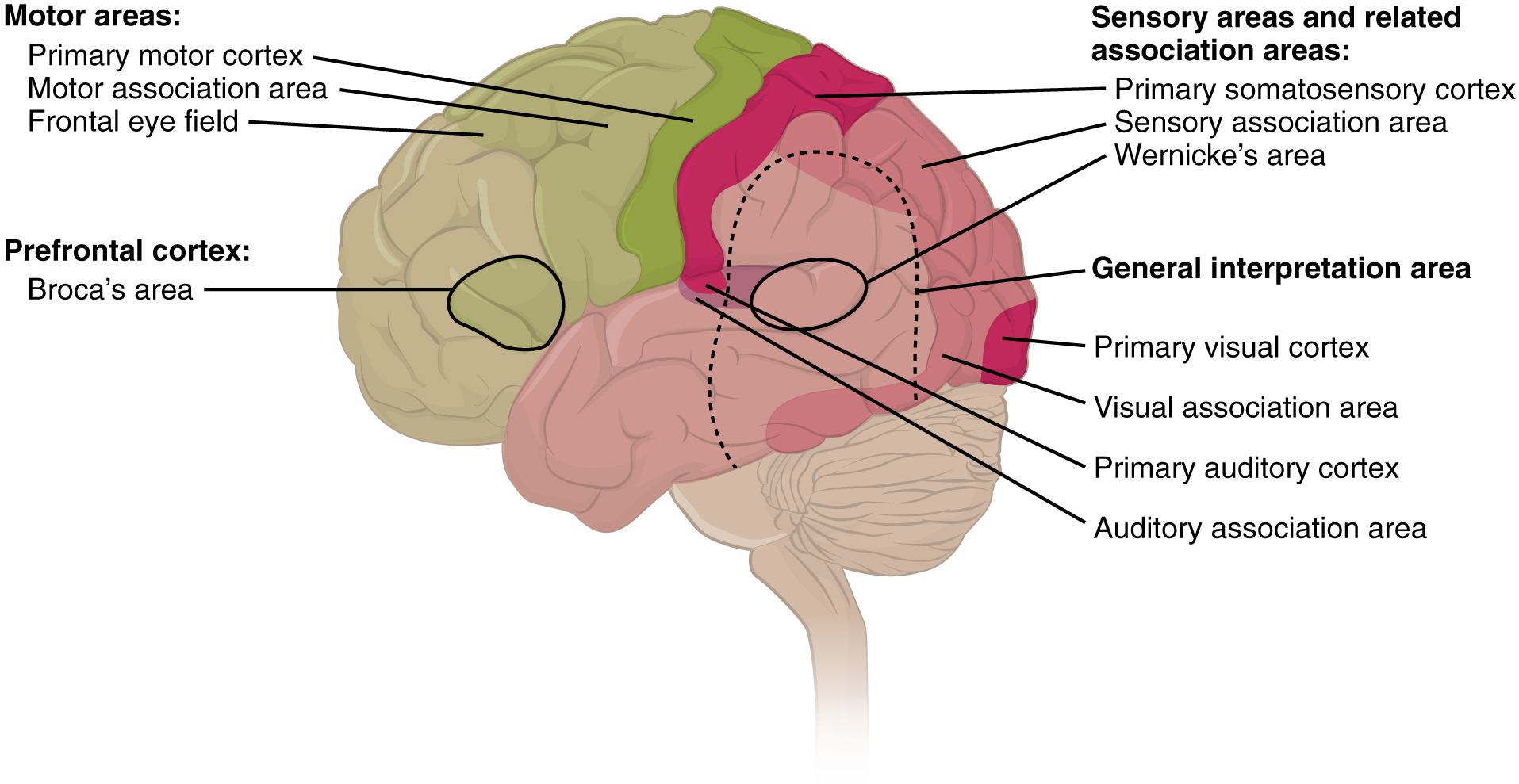
The somatosensory and motor cortex provides an example of the mapping of the human body in different regions of the cortex. The term homunculus comes from the Latin word for “little man” and refers to a map of the human body that is laid across a portion of the cerebral cortex. The sensory receptors are mapped onto the somatosensory cortex and this mapping is called a sensory homunculus (Figure \(\PageIndex{9}\)). In the somatosensory cortex, the external genitals, feet, and lower legs are represented on the medial face of the gyrus within the longitudinal fissure. As the gyrus curves out of the fissure and along the surface of the parietal lobe, the body map continues through the thighs, hips, trunk, shoulders, arms, and hands. The head and face are just lateral to the fingers as the gyrus approaches the lateral sulcus. The representation of the body in this topographical map is medial to lateral from the lower to upper body. Note that this correspondence does not result in a perfectly miniature scale version of the body, but rather exaggerates the more sensitive areas of the body, such as the fingers and lower face. Less sensitive areas of the body, such as the shoulders and back, are mapped to smaller areas on the cortex. Likewise, the motor cortex contains a similar representation of neurons that control the respective body regions. This mapping is called motor homunculus (not shown here).
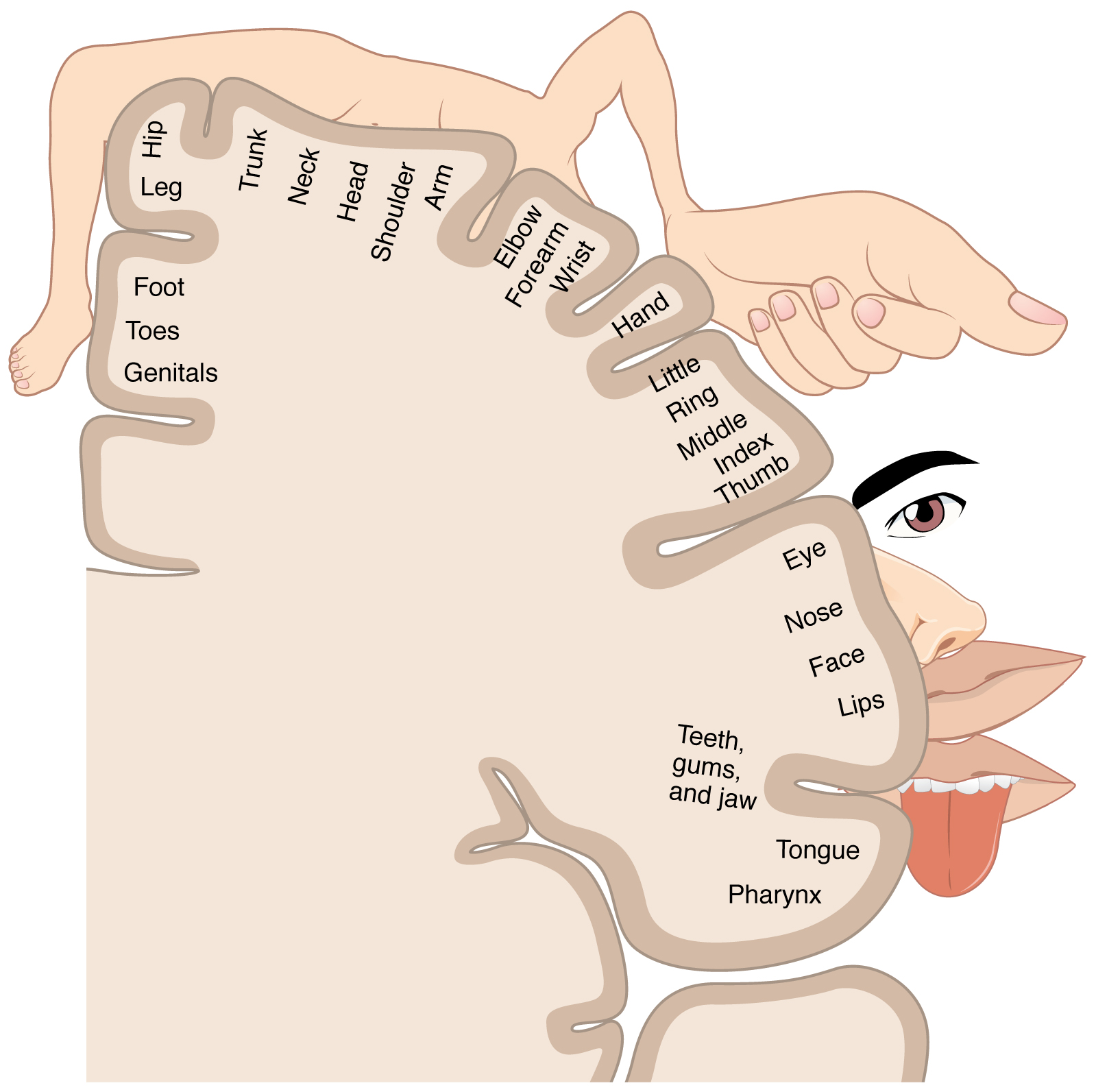
A number of other regions, which extend beyond these primary or association areas of the cortex, are referred to as integrative areas. These areas are found in the spaces between the domains for particular sensory or motor functions, and they integrate multisensory information, or process sensory or motor information in more complex ways. Consider, for example, the posterior parietal cortex that lies between the somatosensory cortex and visual cortex regions. This area is called gnostic area and has been ascribed to the coordination of visual and motor functions, such as reaching to pick up a glass. The somatosensory function that would be part of this is the proprioceptive feedback from moving the arm and hand. The weight of the glass, based on what it contains, will influence how those movements are executed.
Memory and Learning
There are other cognitive abilities of the cerebral cortex. For example, memory is largely a function of the frontal and temporal lobes, along with structures beneath the cerebral cortex. Short-term memory (also called working or active memory) is localized to the prefrontal lobe. Memory is essentially a sensory function: memories are recalled sensations such as the smell of Mom’s baking or the sound of a barking dog. Even memories of movement are really the memory of sensory feedback from those movements, such as stretching muscles or the movement of the skin around a joint. Structures in the temporal lobe are responsible for establishing long-term memory, but the ultimate location of those memories is usually in the region in which the sensory perception was processed.
Language and Speech
Adjacent to the auditory association cortex, at the end of the lateral sulcus just anterior to the visual cortex, is Wernicke’s area (Figure \(\PageIndex{10}\)). Wernicke's area is responsible for the understanding of language, both written and verbal. In the lateral aspect of the frontal lobe, just anterior to the region of the motor cortex associated with the head and neck, is Broca’s area. Broca’s area is responsible for the production of language, or controlling movements responsible for speech. Both area are located only in the left hemisphere in the majority of people. The tendency for some brain functions to be specialized in one side of the brain is called lateralization of function. The language areas are not the only example of lateralization. Another example of lateralization is the somatic sensation of one side of the body crossing at the brainstem to send the information to the hemisphere on the opposite side. Exact math calculation and memory retrieval, for example, tend to be on the left parietal lobe. Both regions were originally described on the basis of losses of speech and language, which is called aphasia. The aphasia associated with Broca’s area is known as an expressive aphasia, which means that speech production is compromised. This type of aphasia is often described as non-fluency because the ability to say some words leads to broken or halting speech. Grammar can also appear to be lost. The aphasia associated with Wernicke’s area is known as a receptive aphasia, which is not a loss of speech production, but a loss of understanding of content. Patients, after recovering from acute forms of this aphasia, report not being able to understand what is said to them or what they are saying themselves, but they often cannot keep from talking.
The two regions are connected by white matter tracts that run between the posterior temporal lobe and the lateral aspect of the frontal lobe. Conduction aphasia associated with damage to this connection refers to the problem of connecting the understanding of language to the production of speech. This is a very rare condition, but is likely to present as an inability to faithfully repeat spoken language.
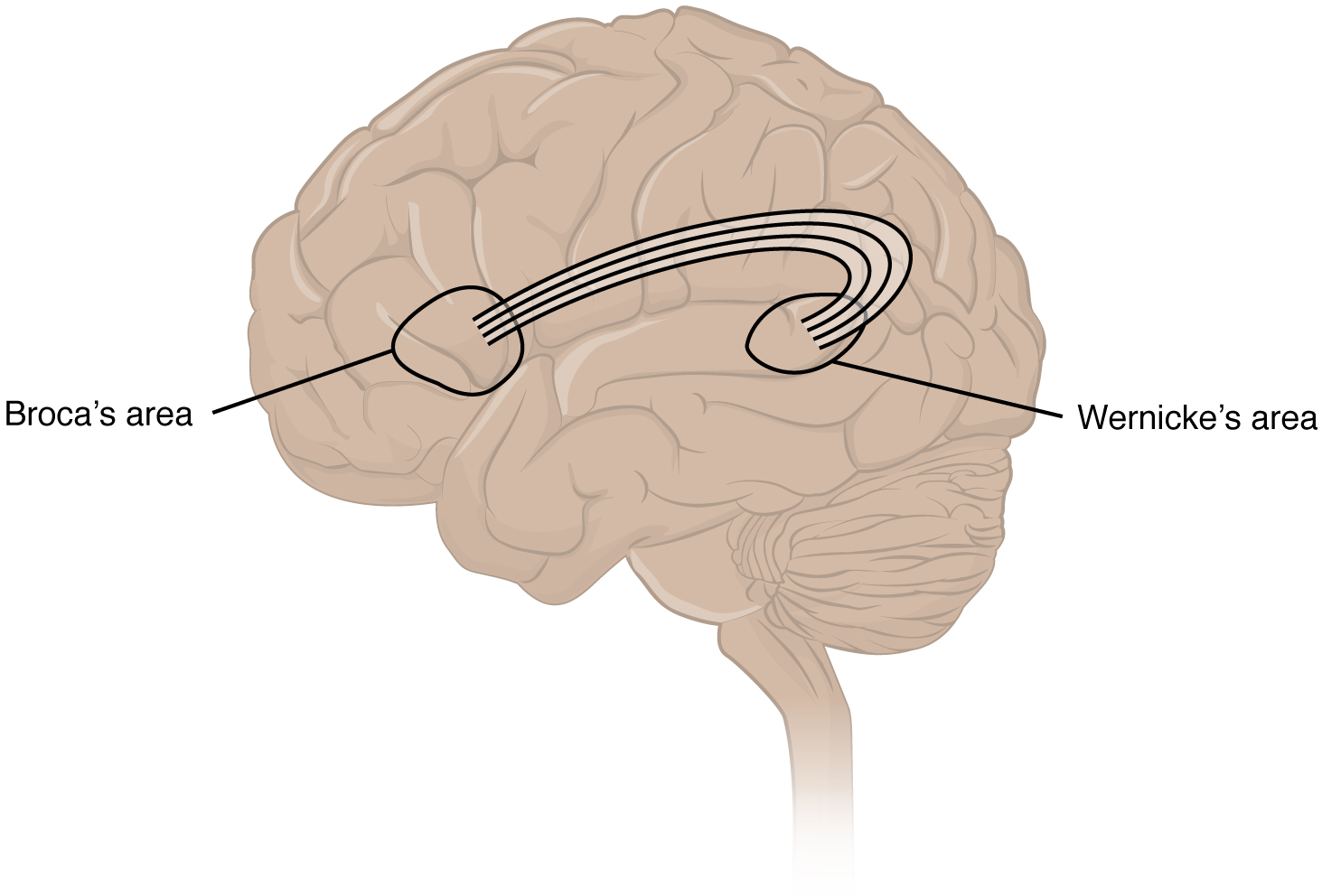
Judgment and Abstract Reasoning
Planning and producing responses requires an ability to make sense of the world around us. Making judgments and reasoning in the abstract are necessary to produce movements as part of larger responses. For example, when your alarm goes off, do you hit the snooze button or jump out of bed? Is 10 extra minutes in bed worth the extra rush to get ready for your day? Will hitting the snooze button multiple times lead to feeling more rested or result in a panic as you run late? How you mentally process these questions can affect your whole day.
The prefrontal cortex is responsible for the functions responsible for planning and making decisions. The prefrontal cortex is composed of the regions of the frontal lobe that are not directly related to specific motor functions. The most posterior region of the frontal lobe, the precentral gyrus, is the primary motor cortex. Anterior to that are the premotor cortex, Broca’s area, and the frontal eye fields, which are all related to planning certain types of movements. Anterior to what could be described as motor association areas are the regions of the prefrontal cortex. They are the regions in which judgment, abstract reasoning, and working memory are localized. The antecedents to planning certain movements are judging whether those movements should be made, as in the example of deciding whether to hit the snooze button.
A psychiatric practice to deal with various disorders was the prefrontal lobotomy. This procedure was common in the 1940s and early 1950s, until antipsychotic drugs became available. The connections between the prefrontal cortex and other regions of the brain were severed. The disorders associated with this procedure included some aspects of what are now referred to as personality disorders, but also included mood disorders and psychoses. Depictions of lobotomies in popular media suggest a link between cutting the white matter of the prefrontal cortex and changes in a patient’s mood and personality, though this correlation is not well understood.
Human Brain Size

Compared with the nearest evolutionary relative, the chimpanzee, the human has a brain that is huge. At a point in the past, a common ancestor gave rise to the two species of humans and chimpanzees. That evolutionary history is long and is still an area of intense study. But something happened to increase the size of the human brain relative to the chimpanzee. Read the article "How did human brains get so big?" in which the author explores the current understanding of why this happened.
According to one hypothesis about the expansion of brain size, what tissue might have been sacrificed so energy was available to grow our larger brain? Based on what you know about that tissue and nervous tissue, why would there be a trade-off between them in terms of energy use?
- Answer
-
Energy is needed for the brain to develop and perform higher cognitive functions. That energy is not available for the muscle tissues to develop and function. The hypothesis suggests that humans have larger brains and less muscle mass, and chimpanzees have the smaller brains but more muscle mass.
Concept Review
The adult brain is separated into four major regions: the cerebrum, the diencephalon, the brainstem, and the cerebellum. The cerebrum is the largest portion and contains the cerebral cortex, subcortical nuclei and white matter tracts. It is divided into two halves called hemispheres by the longitudinal fissure.
The cerebral cortex is the location of important cognitive functions. It is separated into the frontal, parietal, temporal, and occipital lobes. The frontal lobe is responsible for motor functions, from planning movements through executing commands to be sent to the spinal cord and periphery. The most anterior portion of the frontal lobe is the prefrontal cortex, which is associated with aspects of personality through its influence on motor responses in decision-making. The other lobes are responsible for sensory functions. The parietal lobe is where somatosensation is processed. The occipital lobe is where visual processing begins, although the other parts of the brain can contribute to visual function. The temporal lobe contains the cortical area for auditory processing, but also has regions crucial for memory formation.
Subcortical nuclei beneath the cerebral cortex, known as the subcortical or basal nuclei nuclei, are responsible for augmenting cortical functions. The subcortical or basal nuclei receive input from cortical areas and compare it with the general state of the individual. The output influences the activity of part of the thalamus that can then increase or decrease cortical activity that often results in changes to motor commands.
White matter tracts are bundles of myelinated axons that connect different regions of the brain. Commissural tracts such as the corpus callosum extend between the two hemispheres to connect left and right regions of the cerebrum. Association tracts connect different regions within the same hemisphere. Association tracts can be classified into arcuate fibers when they connect gyri of the same lobe or longitudinal fasciculi when they connect gyri in different lobes of the same hemisphere. Projection tracts extend from the cerebral cortex to the inferior regions of the brain and to the spinal cord.
Losses of language and speech functions, known as aphasias, are associated with damage to the important integration areas in the left hemisphere known as Broca’s or Wernicke’s areas, as well as the connections in the white matter between them. Different types of aphasia are named for the particular structures that are damaged.
Review Questions
Q. Brodmann’s areas map different regions of the ________ to particular functions.
A. cerebellum
B. cerebral cortex
C. basal forebrain
D. corpus callosum
- Answer
-
B
Q. Which lobe of the cerebral cortex is responsible for generating motor commands?
A. temporal
B. parietal
C. occipital
D. frontal
- Answer
-
D
Q. Which type of aphasia is more like hearing a foreign language spoken?
A. receptive aphasia
B. expressive aphasia
C. conductive aphasia
D. Broca’s aphasia
- Answer
-
A
Glossary
- aphasia
- loss of language function
- arcuate fibers
- white matter tract that connect gyri of the same lobe
- association area
- region of cortex connected to a primary sensory cortical area that further processes the information to generate more complex sensory perceptions
- association tract
- white matter tract that connect different regions within the same hemisphere
- basal nuclei
- nuclei of the cerebrum (with a few components in the upper brainstem and diencephalon) that are responsible for assessing cortical movement commands and comparing them with the general state of the individual through broad modulatory activity of dopamine neurons; largely related to motor functions, as evidenced through the symptoms of Parkinson’s and Huntington’s diseases
- Broca’s area
- region of the frontal lobe associated with the motor commands necessary for speech production and located only in the cerebral hemisphere responsible for language production, which is the left side in approximately 95 percent of the population
- Brodmann’s areas
- mapping of regions of the cerebral cortex based on microscopic anatomy that relates specific areas to functional differences, as described by Brodmann in the early 1900s
- caudate
- nucleus deep in the cerebrum that is part of the basal nuclei; along with the putamen, it is part of the striatum
- central sulcus
- surface landmark of the cerebral cortex that marks the boundary between the frontal and parietal lobes
- cerebral cortex
- outer gray matter covering the forebrain, marked by wrinkles and folds known as gyri and sulci
- cerebral hemisphere
- one half of the bilaterally symmetrical cerebrum
- cerebrum
- region of the adult brain that develops from the telencephalon and is responsible for higher neurological functions such as memory, emotion, and consciousness
- commissural tract
- white matter tract that extend between the two hemispheres to connect left and right regions of the cerebrum
- conduction aphasia
- loss of language function related to connecting the understanding of speech with the production of speech, without either specific function being lost
- corpus callosum
- large white matter structure that connects the right and left cerebral hemispheres
- expressive aphasia
- loss of the ability to produce language; usually associated with damage to Broca’s area in the frontal lobe
- frontal eye field
- region of the frontal lobe associated with motor commands to orient the eyes toward an object of visual attention
- globus pallidus
- nuclei deep in the cerebrum that are part of the basal nuclei and can be divided into the internal and external segments
- gnostic area
- posterior parietal cortex that lies between the somatosensory cortex and visual cortex regions
- gyrus
- ridge formed by convolutions on the surface of the cerebrum or cerebellum
- insula
- small region of the cerebral cortex located deep within the lateral sulcus
- lateral sulcus
- surface landmark of the cerebral cortex that marks the boundary between the temporal lobe and the frontal and parietal lobes
- lateralization of function
- tendency for some brain functions to be specialized in one side of the brain
- longitudinal fasciculi
- white matter tract that connect gyri in different lobes of the same hemisphere
- longitudinal fissure
- large separation along the midline between the two cerebral hemispheres
- motor homunculus
- topographical representation in the precentral gyrus of motor neurons that control the respective body regions
- occipital lobe
- region of the cerebral cortex directly beneath the occipital bone of the cranium
- parietal lobe
- region of the cerebral cortex directly beneath the parietal bone of the cranium
- parieto-occipital sulcus
- groove in the cerebral cortex representing the border between the parietal and occipital cortices
- postcentral gyrus
- ridge just posterior to the central sulcus, in the parietal lobe, where the primary somatosensory cortex is located
- precentral gyrus
- ridge just anterior to the central sulcus, in the frontal lobe, where the primary motor cortex is located
- prefrontal lobotomy
- Surgical operation where connections between the prefrontal cortex and other regions of the brain are severed
- premotor cortex
- region of the frontal lobe responsible for planning movements that will be executed through the primary motor cortex
- primary auditory cortex
- region of the cerebral cortex within the temporal lobe responsible for the perception of sounds
- primary cortical areas
- primary areas are where sensory information is initially received for conscious perception, or where descending commands are sent down to the brainstem or spinal cord to execute movements
- primary gustatory cortex
- region of the cerebral cortex within the insula responsible for the perception of taste
- primary motor cortex
- located in the precentral gyrus and responsible for the movement of skeletal muscles
- primary olfactory cortex
- region of the cerebral cortex within the temporal lobe responsible for the perception of smell
- primary somatosensory cortex
- located in the postcentral gyrus and responsible for the perception of somatosensation
- primary visual cortex
- region of the cerebral cortex within the occipital lobe responsible for the perception of vision
- projection tract
- white matter tract that extend from the cerebral cortex to the inferior regions of the brain and to the spinal cord
- putamen
- nucleus deep in the cerebrum that is part of the basal nuclei; along with the caudate, it is part of the striatum
- receptive aphasia
- loss of the ability to understand received language, such as what is spoken to the subject or given in written form
- sensory association area
- region of cortex connected to the primary somatosensory cortex that further processes the information to generate more complex sensory perceptions
- sensory homunculus
- topographical representation in the postcentral gyrus of somatosensory neurons that sense the respective body regions
- somatosensation
- general senses related to the body, usually thought of as the senses of touch, which would include pain, temperature, and proprioception
- striatum
- the caudate and putamen collectively, as part of the basal nuclei, which receive input from the cerebral cortex
- sulcus
- groove formed by convolutions in the surface of the cerebral cortex
- temporal lobe
- region of the cerebral cortex directly beneath the temporal bone of the cranium
- tract
- bundle of axons in the central nervous system having the same function and point of origin
- visual association area
- region of cortex connected to the primary visual cortex that further processes the information to generate more complex sensory perceptions
- Wernicke’s area
- region at the posterior end of the lateral sulcus in which speech comprehension is localized
Contributors and Attributions
OpenStax Anatomy & Physiology (CC BY 4.0). Access for free at https://openstax.org/books/anatomy-and-physiology


